
When it comes to data security, few topics are more pertinent today than encryption. To delve deeper into the intricacies of Personal Data Encryption and its implications, I sat down with Alex Thompson, a seasoned expert in digital security. Alex’s journey with data encryption began over a decade ago, and they have witnessed firsthand the evolution of encryption technologies, most recently the introduction of Personal Data Encryption in Windows 11.
“Encryption is like a digital lock and key,” Alex began, setting the stage for what was to be an enlightening conversation. “And with Personal Data Encryption, Microsoft has introduced a sophisticated way to ensure that only the right people have the key.”
Personal Data Encryption, as Alex explained, utilises AES-CBC (Advanced Encryption Standard-Cipher Block Chaining) with a 256-bit key to safeguard content. This approach is robust, providing a high level of security for personal data. “AES-CBC with a 256-bit key is currently one of the strongest encryption methods available,” Alex noted. “It’s like having a vault with a combination lock that’s practically impossible to crack.”
One of the unique aspects of Personal Data Encryption is its two levels of protection, which are tailored to meet different organisational needs. “The level of protection is determined based on the specific requirements of the organisation,” Alex explained. “For instance, Level 1 offers basic protection, ensuring data is accessible only when a user is signed in via Windows Hello for Business. Level 2, however, is more stringent; it makes data inaccessible just a minute after the device is locked.”
This two-tiered system is an intriguing aspect of Personal Data Encryption, offering flexibility and heightened security based on necessity. “For organisations dealing with highly sensitive information, Level 2 is ideal,” Alex elaborated. “It provides an extra layer of security by limiting access even further, which is crucial in environments where data breaches could have severe repercussions.”
A notable feature of Personal Data Encryption is its integration with Windows Hello for Business. This creates a seamless experience for users. “It’s a smart move,” Alex remarked. “By tying encryption keys to biometric credentials or a PIN, Microsoft has reduced the number of credentials users need to handle. It’s more secure and user-friendly.”
Alex highlighted that this integration also differentiates Personal Data Encryption from other forms of encryption like BitLocker. “BitLocker encrypts entire volumes, whereas Personal Data Encryption focuses on individual files,” Alex said. “This means you can have a more granular level of control over what gets encrypted.”
The conversation shifted to the practical aspects of using Personal Data Encryption. Alex pointed out that certain prerequisites must be met, such as having a device running Windows 11, version 22H2 or later, and being signed in with Windows Hello for Business. “It’s important to have the right setup,” Alex advised. “Without these prerequisites, you won’t be able to access the full range of features Personal Data Encryption offers.”
For users concerned about data accessibility, Alex reassured that protected files are marked with a padlock icon, making it easy to identify encrypted content. “If you’re not signed in correctly, you simply won’t be able to access these files,” Alex explained, underscoring the importance of using the correct sign-in method.
Beyond the technicalities, Alex also touched on personal experiences with encryption. “Working in digital security, I’ve seen the consequences of poor data protection,” they reflected. “Personal Data Encryption is a crucial tool in today’s digital landscape, and its importance cannot be overstated.”
During our discussion, Alex also provided practical recommendations for users considering Personal Data Encryption. “It’s wise to use it alongside BitLocker,” they suggested. “The combination of both offers a comprehensive security solution that’s hard to beat.”
In closing, Alex emphasised the significance of backups. “Encryption is only as good as your ability to access your data,” they warned. “In the event of a PIN reset or device failure, having a backup is essential to avoid data loss.”
As our conversation wrapped up, it was clear that Personal Data Encryption is a powerful tool in the fight against data breaches. It combines robust encryption standards with user-friendly features, making it a viable option for individuals and organisations alike. Through Alex’s insights, I gained a deeper appreciation for the balance between security and accessibility that Personal Data Encryption strives to achieve.
Fallon Foss

